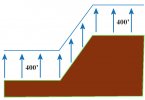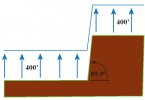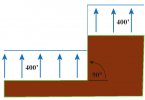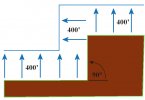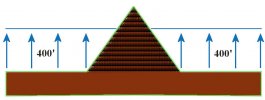Ah, okay that makes more sense, sort of...

But that just proves my point, doesn't it?
The whole idea behind the 400' AGL ceiling for unmanned aircraft is to maintain a safe 100' separation from manned aircraft which should (generally) be flying more than 500' AGL. And that 500' height for manned aircraft is measured above
any ground obstacles.
If there is a 500' tall apartment building in the way, manned aircraft cannot just buzz across inches above the roof at 500' AGL. They have to climb an additional 500' to 1000' AGL to safely clear that
ground obstacle.
So in my hypothetical example of a forest with 400' tall trees, manned aircraft should stay at least an
additional 500' higher than the treetops (i.e. 900' above the ground surface). Why then should unmanned recreational aircraft instead always be restricted to 400' AGL measured from the earth's
surface, rather than
also from the top of
any ground obstacle?
If it's a 400' tall hill, unmanned aircraft
are allowed to fly up to an additional 400' above any hilltop, as that is still the same 400' AGL measured above the earth's surface (above the hilltop).
But if it's a similarly shaped 400' tall man-made pyramid, everyone insists the regulations are clear and recreational drones must fly
around that particular man-made
ground obstacle, because recreational flyers are never permitted to fly above 400' AGL, even though the 500' airspace above
any ground obstacle is supposedly otherwise safely clear of manned aircraft.
That's the bit that I find absurd.
I know I've mentioned this many times, but in Canada we no longer have any distinction between Recreational vs Commercial drone operations. The exact same regulations apply equally regardless of intent. The only major difference is between the easier
Basic operations versus
Advanced operations. With only a Basic certificate you cannot fly within any controlled airspace. If you need to fly there, then you must hold an Advanced certificate.
Even the Canadian allowance for flying higher over structures taller than 400' applies equally to both Basic or Advanced operations (again regardless of recreational vs commercial intent), unless that additional height puts you into an overhead controlled airspace. Controlled airspace always requires an Advanced certificate as well as coordination with the airspace controller.
But, if you're flying drones under 250 grams,
none of those Basic or Advanced regulations apply at all. Only the "Don't be Stupid" rule still applies. Don't interfere with manned flight and don't be a hazard to people on the ground. There is no actual legal restriction specifically limiting AGL height when flying sub-250g, other than the obvious "Don't be Stupid" rule.
That's why I find it so odd that you still have this bizarre distinction between recreational and commercial drone operations with weird interpretations of recreational flyers not being allowed to fly above a forest if the trees are taller than 400' because that would exceed their 400' AGL restriction. Oh no, you'd need a Part 107 commercial permit for that...
I tried that, but I can only find references to "structures" within CFR Part 77. I was just curious if there's actually an official legal definition. In the USA, recreational flyers
can fly over a 400' tall hilltop, but
not over a 400' "structure". Hmmmm ?




